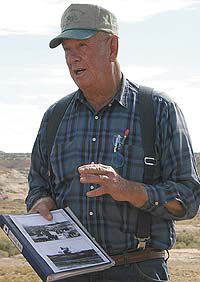| Vernell Rowley tells the story of the Morrison/Knudsen project in the San Rafael Swell in the late 40s and early 50s. |
The Emery County Historical Society went on their annual trek recently. They met at the corrals just east of Castle Dale and Mervin Miles led the procession. At the first stop, Ramal and Carole Jones told of their finding new species of dinosaurs just miles from Castle Dale.
“We had been hunting dinosaurs since 1980 and on that particular day we were in a place where no signs were expected to be found,” said Ramal. He went on to tell the story of how the dinosaurs came to be in the San Rafael Swell. When Carole found the first piece of a rib bone, they notified the College of Eastern Utah. CEU applied for and received the permits to excavate and the skeleton was located. A life size replica, which incidentally is named after Carole, is located in the Ogden Dino Park.
Later, Ramal found another portion of bone and another species was named, this time after him. The couple dug on these sites for seven years. The Museum of the San Rafael is in the process of ordering the dinosaur named for Ramal.
At the second stop of the day, Vernell Rowley told of the Morrison-Knudsen excavations in the Swell in the late 1940s and early 50s. The government detonated two explosions in the sandstone in the Swell looking for an area that would withstand an atomic bomb blast. Following the two explosions, the sandstone was deemed inappropriate for the needs.
During the four years the Army Corps of Engineers was in the Swell, they built a small shanty town where they lived. Other relics of their stay can still be seen in the Buckhorn area. The old powder magazine is still there, and the MK tunnels, where the explosions took place, are still visited every day.
| Reed Martin stands in front of the Buckhorn Panel while he tells the Emery County Historical Society members about the restoration of the panel. |
Reed Martin was the speaker at the third stop, the Buckhorn Panel pictographs. On this particular day, four members, including Martin, Karen Huntsman, Bert Oman and Jim Nelson, were present from the original Buckhorn Restoration committee who undertook to restore the panel to near original condition.
The restoration project began in 1992 as a suggestion by Huntsman for the Centennial Project for Emery County. It was undertaken, completed, and was dedicated in September of 1995. “This is just one of many sites of pictographs throughout Utah. It is 3,000-5,000 years old and is of the Barrier Canyon paintings. These paintings and drawings are all that remain of the Barrier Canyon culture,” said Martin.
Martin concluded, “We are all rock art experts. We weren’t there to know the meaning of the pictographs. Only the artist himself knows.”
As the group proceeded down the Buckhorn, they stopped at Swinging Bridge for a lunch of hot dogs, hamburgers, and pot luck. On the journey back through the canyon, Miles showed the group many other Indian writings that line the canyon walls.
The Emery County Historical Society meets once a month with interesting studies of the history of the Emery County area. For more information or to join, call Joyce Staley at 748-5165.

